
The small worlds of our solar system help us trace its history and evolution, including comets. This video clip was compiled from images taken by NASA’s EPOXI mission spacecraft during its flyby of comet Hartley 2 on November 4, 2010. Credit: NASA/JPL-Caltech/UMD
The entire history of human existence is a tiny blip in our solar system’s 4.5-billion-year history. No one was around to see planets forming and undergoing dramatic changes before settling into their present configuration. In order to understand what came before us — before life on Earth and before Earth itself — scientists need to hunt for clues to that mysterious distant past.
Those clues come in the form of asteroids, comets, and other small objects. Like detectives sifting through forensic evidence, scientists carefully examine these small bodies for insights about our origins. They tell of a time when countless meteors and asteroids rained down on the planets, burned up in the Sun, shot out beyond the orbit of Neptune or collided with one another and shattered into smaller bodies. From distant, icy comets to the asteroid that ended the reign of the dinosaurs, each space rock contains clues to epic events that shaped the solar system as we know it today — including life on Earth.
NASA’s missions to study these “non-planets” help us understand how planets including Earth formed, locate hazards from incoming objects and think about the future of exploration. They have played key roles in our solar system’s history, and reflect how it continues to change today.
“They might not have giant volcanoes, global oceans, or dust storms, but small worlds could answer big questions we have about the origins of our solar system,” said Lori Glaze, acting director for the Planetary Science Division at NASA Headquarters in Washington.
NASA has a long history of exploring small bodies, beginning with Galileo’s 1991 flyby of asteroid Gaspra. The first spacecraft to orbit an asteroid, Near Earth Asteroid Rendezvous (NEAR) Shoemaker, also successfully landed on asteroid Eros in 2000 and took measurements that originally hadn’t been planned. The Deep Impact mission drove a probe into Comet Tempel 1 in 2005 and prompted scientists to rethink where comets formed. More recent efforts have built on those successes and will continue to teach us more about our solar system. Here’s an overview of what we can learn:
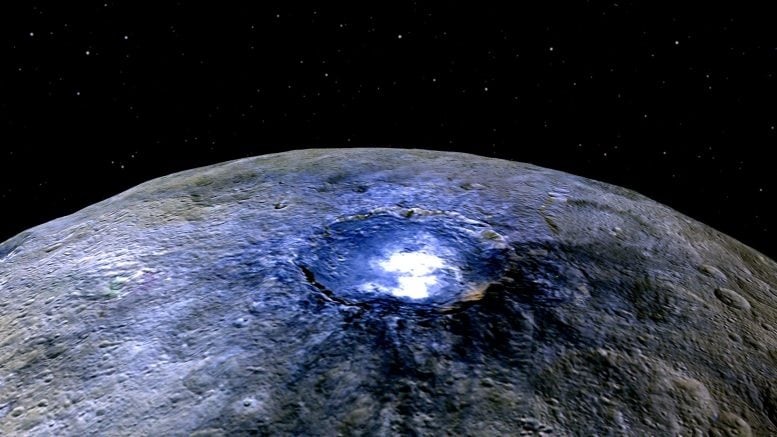
This representation of Ceres’ Occator Crater in false colors shows differences in the surface composition. Credit: NASA/JPL-Caltech/UCLA/MPS/DLR/IDA
Building Blocks of Planets
Our solar system as we know it today formed from grains of dust — tiny particles of rock, metal, and ice — swirling in a disk around our infant Sun. Most of the material from this disk fell into the newborn star, but some bits avoided that fate and stuck together, growing into asteroids, comets, and even planets. Lots of leftovers from that process have survived to this day. The growth of planets from smaller objects is one piece of our history that asteroids and comets can help us investigate.
“Asteroids, comets, and other small bodies hold material from the solar system’s birth. If we want to know where we come from, we must study these objects,” Glaze said.
Two ancient fossils providing clues to this story are Vesta and Ceres, the largest bodies in the asteroid belt between Mars and Jupiter. NASA’s Dawn spacecraft, which recently ended its mission, orbited both of them and showed definitively that they are not part of the regular “asteroid club.” While many asteroids are loose collections of rubble, the interiors of Vesta and Ceres are layered, with the densest material at their cores. (In scientific terms, their interiors are said to be “differentiated.”) This indicates both of these bodies were on their way to becoming planets, but their growth was stunted — they never had enough material to get as big as the major planets.
But while Vesta is largely dry, Ceres is wet. It may have as much as 25 percent water, mostly bound up in minerals or ice, with the possibility of underground liquid. The presence of ammonia at Ceres is also interesting, because it typically requires cooler temperatures than Ceres’ current location. This indicates the dwarf planet could have formed beyond Jupiter and migrated in, or at least incorporated materials that originated farther from the Sun. The mystery of Ceres’ origins shows how complex planetary formation can be, and it underscores the complicated history of our solar system.
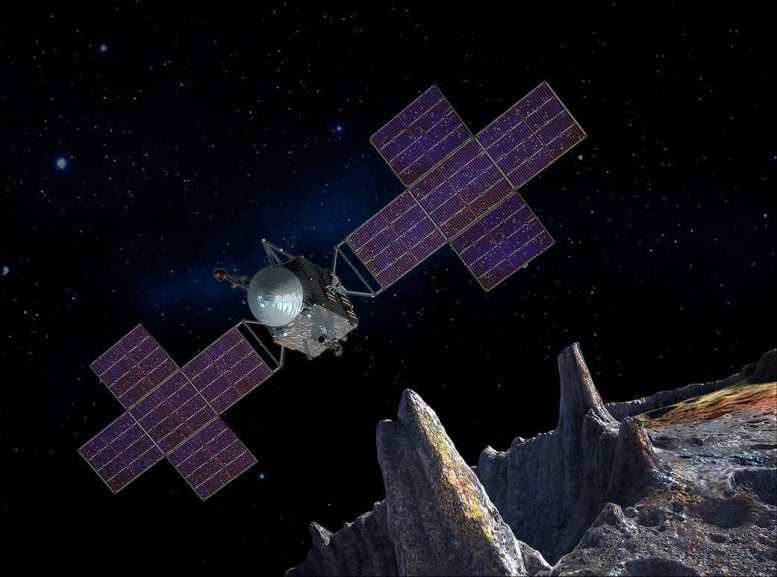
This artist’s concept depicts the spacecraft of NASA’s Psyche mission near the mission’s target, the metal asteroid Psyche. Credit: NASA/JPL-Caltech/Arizona State Univ./Space Systems Loral/Peter Rubin
Although we can indirectly study the deep interiors of the planets for clues about their origins, as NASA’s InSight mission will do on Mars, it’s impossible to drill down into the core of any sizeable object in space, including Earth. Nevertheless, a rare object called Psyche may offer the opportunity to explore a planet-like body’s core without any digging. Asteroid Psyche appears to be the exposed iron-nickel core of a protoplanet — a small world that formed early in our solar system’s history but never reached planetary size. Like Vesta and Ceres, Psyche saw its path to planethood disrupted. NASA’s Psyche mission, launching in 2022, will help tell the story of planet formation by studying this metal object in detail.
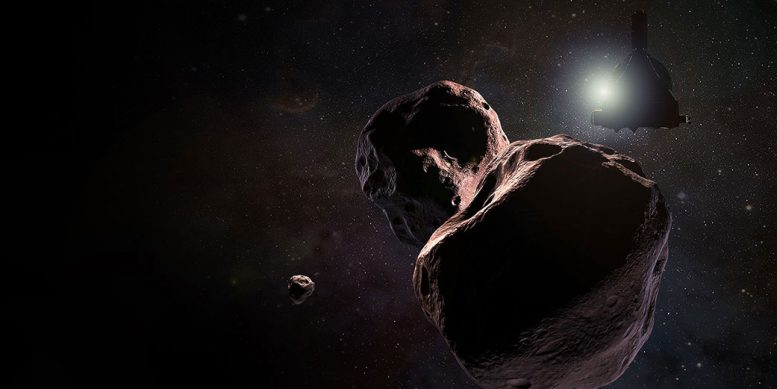
Artist’s impression of NASA’s New Horizons spacecraft encountering 2014 MU69, a Kuiper Belt object that orbits the Sun 1 billion miles (1.6 billion kilometers) beyond Pluto, on Jan. 1, 2019. Credit: NASA/JHUAPL/SwRI
Farther afield, NASA’s New Horizons spacecraft is currently on its way to a distant object called 2014 MU69, nicknamed “Ultima Thule” by the mission. One billion miles farther from the Sun than Pluto, MU69 is a resident of the Kuiper Belt, a region of ice-rich objects beyond the orbit of Neptune. Objects like MU69 may represent the most primitive, or unaltered, material that remains in the solar system. While the planets orbit in ellipses around the Sun, MU69 and many other Kuiper Belt objects have very circular orbits, suggesting they have not moved from their original paths in 4.5 billion years. These objects may represent the building blocks of Pluto and other distant icy worlds like it. New Horizons will make its closest approach to MU69 on Jan. 1, 2019 — the farthest planetary flyby in history.
“Ultima Thule is incredibly scientifically valuable for understanding the origin of our solar system and its planets,” said Alan Stern, principal investigator of New Horizons, based at Southwest Research Institute in Boulder, Colorado. “It’s ancient and pristine, and not like anything we’ve seen before.”
Delivery of the Elements of Life
Small worlds are also likely responsible for seeding Earth with the ingredients for life. Studying how much water they have is evidence of how they helped seed life on Earth.
“Small bodies are the game changers. They participate in the slow and steady evolution of our solar system over time, and influence planetary atmospheres and opportunities for life. Earth is part of that story,” said NASA’s chief scientist Jim Green.
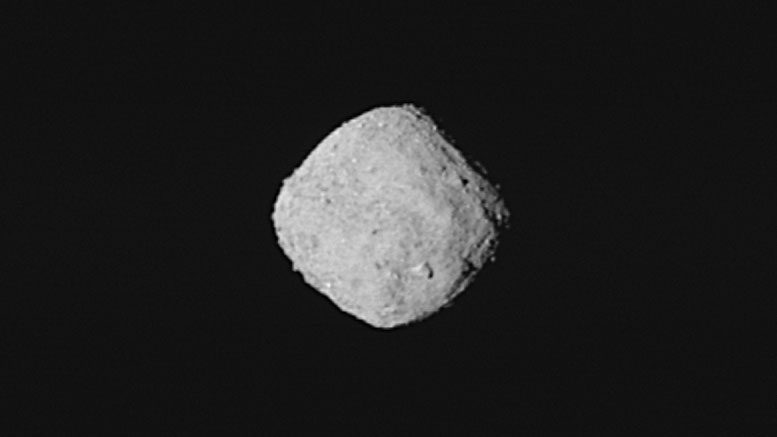
This “super-resolution” view of asteroid Bennu was created using eight images obtained by NASA’s OSIRIS-REx spacecraft on October 29, 2018, from a distance of about 205 miles (330 kilometers). Credit: NASA/Goddard/University of Arizona
One example of an asteroid containing the building blocks of life is Bennu, the target of NASA’s OSIRIS-REx (Origins, Spectral Interpretation, Resource Identification, Security-Regolith Explorer) mission. Bennu may be loaded with molecules of carbon and water, both of which are necessary for life as we know it. As Earth formed, and afterward, objects like Bennu rained down and delivered these materials to our planet. These objects did not have oceans themselves, but rather water molecules bound up in minerals. Up to 80 percent of Earth’s water is thought to have come from small bodies like Bennu. By studying Bennu, we can better understand the kinds of objects that allowed a barren young Earth to blossom with life.
Bennu likely originated in the main asteroid belt between Mars and Jupiter, and it’s thought to have survived a catastrophic collision that happened between 800 million and 2 billion years ago. Scientists think a big, carbon-rich asteroid shattered into thousands of pieces, and Bennu is one of the remnants. Rather than a solid object, Bennu is thought to be a “rubble pile” asteroid — a loose collection of rocks stuck together through gravity and another force scientists call “cohesion.” OSIRIS-REx, which will arrive at Bennu in early December 2018, after a 1.2-billion-mile (2-billion-kilometer) journey, and will bring back a sample of this intriguing object to Earth in a sample-return capsule in 2023.
The Japanese Hayabusa-2 mission is also looking at an asteroid from the same family of bodies thought to have delivered ingredients for life to Earth. Currently in orbit at asteroid Ryugu, with small hopping rovers on the surface, the mission will collect samples and return them in a capsule to Earth for analysis by the end of 2020. We will learn a lot comparing Bennu and Ryugu, and understanding the similarities and differences between their samples.
Tracers of Solar System Evolution
Most of the material that formed our solar system, including Earth, didn’t live to tell the tale. It fell into the Sun or was ejected beyond the reaches of our most powerful telescopes; only a small fraction formed the planets. But there are some renegade remnants of the early days when the stuff of planets swirled with an uncertain fate around the Sun.
A particularly catastrophic time for the solar system was between 50 and 500 million years after the Sun formed. Jupiter and Saturn, our system’s most massive giants, reorganized the objects around them as their gravity interacted with smaller worlds such as asteroids. Uranus and Neptune may have originated closer to the Sun and been kicked outward as Jupiter and Saturn moved around. Saturn, in fact, may have prevented Jupiter from “eating” some of the terrestrial planets, including Earth, as its gravity counteracted Jupiter’s further movement toward the Sun.
Swarms of asteroids called the Trojans could help sort out the details of that turbulent period. The Trojans comprise two clusters of small bodies that share Jupiter’s orbit around the Sun, with one group ahead of Jupiter and one trailing behind. But some Trojans seem to be made of different materials than others, as indicated by their varying colors. Some are much redder than others and may have originated beyond the orbit of Neptune, while the grayer ones may have formed much closer to the Sun. The leading theory is that as Jupiter moved around long ago, these objects were corralled into Lagrange points — places where the gravity of Jupiter and the Sun create holding areas where asteroids can be captured. The Trojans’ diversity, scientists say, reflects Jupiter’s journey to its present location. “They’re the remnants of what was going on the last time Jupiter moved,” said Hal Levison, a researcher at Southwest Research Institute.
NASA’s Lucy mission, launching in October 2021, will send a spacecraft to the Trojans for the first time, thoroughly investigating six Trojans (three asteroids in each swarm). For Levison, the mission’s principal investigator, the spacecraft will test ideas he and colleagues have been working on for decades about Jupiter’s reshaping of the solar system. “What would really be interesting is what we don’t expect,” he said.
Processes in an Evolving Solar System
After sundown, under the right conditions, you may notice scattered sunlight in the ecliptic plane, the region of the sky where the planets orbit. This is because sunlight is being scattered by dust left over from the collisions of small bodies such as comets and asteroids. Scientists call this phenomenon “zodiacal light,” and it’s an indication that our solar system is still active. Zodiacal dust around other stars indicates that they, too, may harbor active planetary systems.
Dust from small bodies has had an important role in our planet in particular. About 100 tons of meteoritic material and dust material fall on Earth every day. Some of it comes from comets, whose activity has direct implications for Earth’s evolution. As comets approach the Sun and experience its heat, gases inside the comet bubble up and carry away dusty material from the comet — including ingredients for life. NASA’s Stardust spacecraft flew by Comet 81P/Wild and found that cometary dust contains amino acids, which are the building blocks of life.
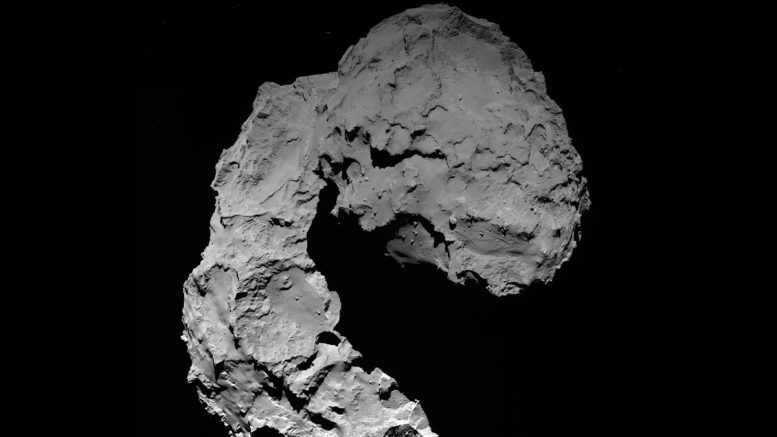
This view shows Comet 67P/Churyumov-Gerasimenko as seen by the OSIRIS wide-angle camera on ESA’s Rosetta spacecraft on September 29, 2016, when Rosetta was at an altitude of 14 miles (23 kilometers). Credit: ESA/Rosetta/MPS for OSIRIS Team MPS/UPD/LAM/IAA/SSO/INTA/UPM/DASP/IDA
Occasional outbursts of gas and dust observed in comets indicate activity on or near their surfaces, such as landslides. The European Space Agency’s Rosetta mission, which completed its exploration of Comet 67P/Churyumov-Gerasimenko in 2016, delivered unprecedented insights about the cometary activity. Among the changes in the comet, the spacecraft observed a massive cliff collapse, a large crack get bigger, and a boulder move. “We discovered that boulders the size of a large truck could be moved across the comet’s surface a distance as long as one-and-a-half football fields,” Ramy El-Maarry, a member of the U.S. Rosetta science team from the University of Colorado, Boulder, said in 2017.
Comets also influence planetary motion today. As Jupiter continues to fling comets outward, it moves inward ever so slightly because of the gravitational dance with the icy bodies. Neptune, meanwhile, throws comets inward and in turn gets a tiny outward push. Uranus and Saturn are also moving outward very slowly in this process.
“Right now we’re talking about teeny amounts of motions because there’s not a lot of mass left,” Levison said.
Fun fact: The spacecraft that has seen the most comets is NASA’s Solar & Heliospheric Observatory (SOHO), most famous for its study of the Sun. SOHO has seen the Sun “eat” thousands of comets, which means that these small worlds were spraying material in the inner part of the solar system on their journey to become the Sun’s dinner.
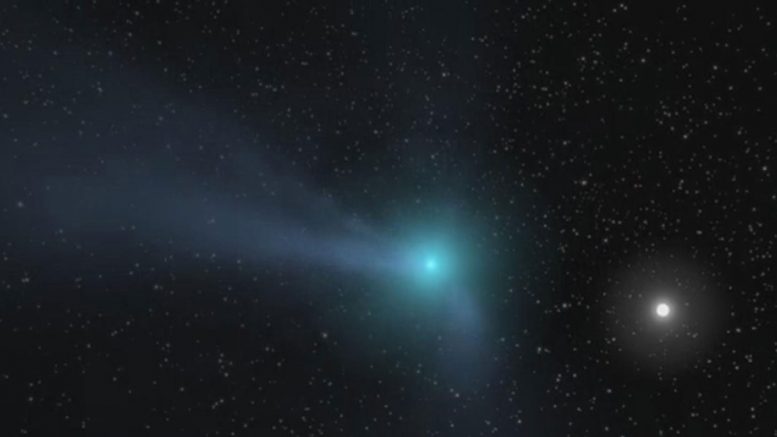
This animation portrays a comet as it approaches the inner solar system. Light from the Sun warms the comet’s core, or nucleus, an object so small it cannot be seen at this scale. Credit: NASA/JPL-Caltech
Hazards to Earth
Asteroids can still pose an impact hazard to the planets, including our own.
While the Trojans are stuck being Jupiter groupies, Bennu, the target of the OSIRIS-REx mission, is one of the most potentially hazardous asteroids to Earth that is currently known, even though its odds of colliding with Earth are still relatively small; scientists estimate Bennu has a 1‐in‐2,700 chance of impacting our planet during one of its close approaches to Earth in the late 22nd century. Right now, scientists can predict Bennu’s path quite precisely through the year 2135, when the asteroid will make one of its close passes by Earth. Close observations by OSIRIS-REx will get an even tighter handle on Bennu’s journey, and help scientists working on safeguarding our planet against hazardous asteroids to better understand what it would take to deflect one on an impact trajectory.
“We’re developing a lot of technologies for operating with precision around these kinds of bodies, and targeting locations on their surfaces, as well as characterizing their overall physical and chemical properties. You would need this information if you wanted to design an asteroid deflection mission,” said Dante Lauretta, principal investigator for the OSIRIS-REx mission, based at the University of Arizona in Tucson.
This animation shows how NASA’s Double Asteroid Redirection Test (DART) would target and strike the smaller (left) element of the binary asteroid Didymos to demonstrate how a kinetic impact could potentially redirect an asteroid as part of the agency’s planetary defense program. Credit: NASA/JHUAPL
Another upcoming mission that will test a technique for defending the planet from naturally occurring impact hazards is NASA’s Double Asteroid Redirection Test (DART) mission, which will attempt to change a small asteroid’s motion. How? Kinetic impact — in other words, collide something with it, but in a more precise and controlled way than nature does it.
DART’s target is Didymos, a binary asteroid composed of two objects orbiting each other. The larger body is about half a mile (800 meters) across, with a small moonlet that is less than one-tenth of a mile (150 meters) wide. An asteroid this size could result in widespread regional damage if one were to impact Earth. DART will deliberately crash itself into the moonlet to slightly change the small object’s orbital speed. Telescopes on Earth will then measure this change in speed by observing the new period of time it takes the moonlet to complete an orbit around the main body, which is expected to be a change of less than a fraction of one percent. But even that small of a change could be enough to make a predicted impactor miss Earth in some future impact scenario. The spacecraft, being built by the Johns Hopkins University Applied Physics Laboratory, is scheduled for launch in spring-summer 2021.
Didymos and Bennu are just two of the almost 19,000 known near-Earth asteroids. There are over 8,300 known near-Earth asteroids the size of the moonlet of Didymos and larger, but scientists estimate that about 25,000 asteroids in that size range exist in near-Earth space. The space telescope helping scientists discover and understand these kinds of objects, including potential hazards, is called NEOWISE (which stands for Near-Earth Object Wide-field Infrared Survey Explorer).
“For most asteroids, we know little about them except for their orbit and how bright they look. With NEOWISE, we can use the heat emitted from the objects to give us a better assessment of their sizes,” said Amy Mainzer, principal investigator of NEOWISE, based at NASA’s Jet Propulsion Laboratory. “That’s important because asteroid impacts can pack quite a punch, and the amount of energy depends strongly on the size of the object.”
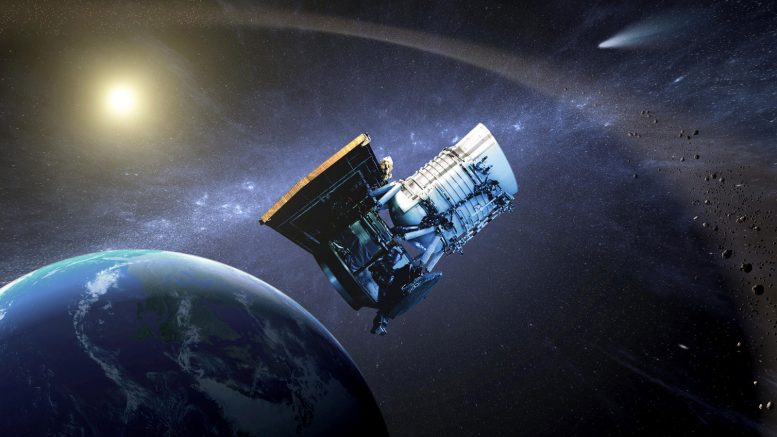
This artist’s concept shows the Wide-field Infrared Survey Explorer, or WISE, spacecraft, in its orbit around Earth. In its NEOWISE mission it finds and characterizes asteroids. Credit: NASA/JPL-Caltech
Small Worlds as Pit Stops, Resources for Future Exploration
There are no gas stations in space yet, but scientists and engineers are already starting to think about how asteroids could one day serve as refueling stations for spacecraft on the way to farther-flung destinations. These small worlds might also help astronauts restock their supplies. For example, Bennu likely has water bound in clay minerals, which could perhaps one day be harvested for hydrating thirsty space travelers.
“In addition to science, the future will indeed be mining,” Green said. “The materials in space will be used in space for further exploration.”
How did metals get on asteroids? As they formed, asteroids and other small worlds collected heavy elements forged billions of years ago. Iron and nickel found in asteroids were produced by previous generations of stars and incorporated in the formation of our solar system.
These small bodies also contain heavier metals forged in stellar explosions called supernovae. The violent death of a star, which can lead to the creation of a black hole, spreads elements heavier than hydrogen and helium throughout the universe. These include metals like gold, silver, and platinum, as well as oxygen, carbon, and other elements we need for survival. Another kind of cataclysm — the collision of supernova remnants called neutron stars — can also create and spread heavy metals. In this way, small bodies are also forensic evidence of the explosions or collisions of long-dead stars.
Because of big things, we now have a lot of very small things. And from small things, we get big clues about our past — and possibly resources for our future. Exploring these objects is important, even if they aren’t planets.
They are small worlds, after all.

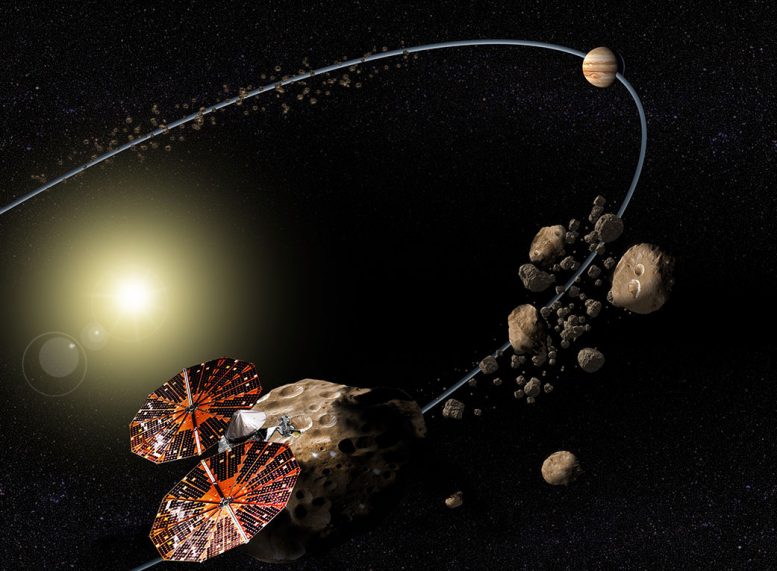
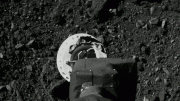
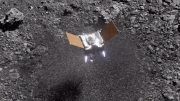
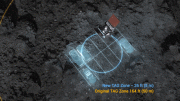


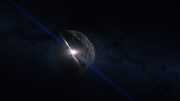
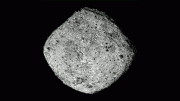

Be the first to comment on "Asteroids, Comets and Other Small Objects Provide Clues of Mysterious Distant Past"